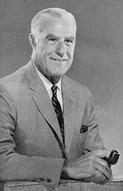Herbert Blumer
From Geography
JensLubben (Talk | contribs) |
JoepGobbens (Talk | contribs) |
||
| (4 intermediate revisions not shown) | |||
| Line 1: | Line 1: | ||
[[File:Herbert_Blumer.jpg|190px|thumb|right|Herbert Georg Blumer]] | [[File:Herbert_Blumer.jpg|190px|thumb|right|Herbert Georg Blumer]] | ||
| - | Herbert George Blumer | + | == Background == |
| + | Herbert George Blumer was born in 1900 in ST. Louis, Missouri. He attended the University of Missouri from 1918 to 1922. After graduation he first taught at the University of Missouri. In 1925 he started teachin at the University of Chicago were he met, and was greatly influenced by George Herbert Mead, William Thomas and Robert Park. In 1952 he became the president of the American Sociological Association. | ||
| + | Blumer played football professionally at the university of Chicago. | ||
| - | Blumer invented the term [[symbolic interactionism]] in 1937. In this he was continuing the work of [[George Mead]], his tutor. | + | |
| + | == Contributions == | ||
| + | Blumer invented the term [[symbolic interactionism]] in 1937. In this he was continuing the work of [[George Mead]], his tutor. Prior to this Blumer thought there were two traditional ways in which to understand the meaning of things. These where either the realist approach or the opposite, whereby the first, the realist would say that the meaning is inherent in the thing, and the opposite, the subjective theory attributes meaning to psychological make-up (Mann, 2007). | ||
According to Blumer, people interact with each other by interpreting other persons actions. So interaction is based on symbolic interpreted reactions instead of physical direct (re)actions. | According to Blumer, people interact with each other by interpreting other persons actions. So interaction is based on symbolic interpreted reactions instead of physical direct (re)actions. | ||
Blumer was also influenced by John Dewey [http://en.wikipedia.org/wiki/John_Dewey], who insisted that human beings are best understood in relation to their environment. | Blumer was also influenced by John Dewey [http://en.wikipedia.org/wiki/John_Dewey], who insisted that human beings are best understood in relation to their environment. | ||
| Line 13: | Line 17: | ||
| - | + | == References == | |
Blumer, H. (1969). Symbolic Interactionism: Perspective and Method. Englewood Cliffs, NJ: Prentice-Hall. | Blumer, H. (1969). Symbolic Interactionism: Perspective and Method. Englewood Cliffs, NJ: Prentice-Hall. | ||
| + | |||
| + | International encyclopedia of the social sciences. (2008). ''Herbert Blumer'' Found 23 October 2012, at http://www.encyclopedia.com/topic/Herbert_Blumer.aspx | ||
| + | |||
| + | Mann, D. (2007). Understanding society: a survey of modern social theory. TOronto: Oxford University Press. | ||
---- | ---- | ||
| Line 23: | Line 31: | ||
Page enhanced bij [[User:JensLubben|JensLubben]] 00:00, 17 December 2011 (CET) | Page enhanced bij [[User:JensLubben|JensLubben]] 00:00, 17 December 2011 (CET) | ||
| + | |||
| + | Edited by [[User:JoepGobbens|JoepGobbens]] 11:14, 21 October 2012 | ||
| + | |||
| + | Page enhanced by Doris Roelvink | ||
Latest revision as of 11:52, 25 October 2012
Background
Herbert George Blumer was born in 1900 in ST. Louis, Missouri. He attended the University of Missouri from 1918 to 1922. After graduation he first taught at the University of Missouri. In 1925 he started teachin at the University of Chicago were he met, and was greatly influenced by George Herbert Mead, William Thomas and Robert Park. In 1952 he became the president of the American Sociological Association. Blumer played football professionally at the university of Chicago.
Contributions
Blumer invented the term symbolic interactionism in 1937. In this he was continuing the work of George Mead, his tutor. Prior to this Blumer thought there were two traditional ways in which to understand the meaning of things. These where either the realist approach or the opposite, whereby the first, the realist would say that the meaning is inherent in the thing, and the opposite, the subjective theory attributes meaning to psychological make-up (Mann, 2007). According to Blumer, people interact with each other by interpreting other persons actions. So interaction is based on symbolic interpreted reactions instead of physical direct (re)actions. Blumer was also influenced by John Dewey [1], who insisted that human beings are best understood in relation to their environment. Blumer's idea is criticized for putting too much emphasis on day-to-day life and the social formation of the individual while ignoring social structure
While it is not possible to capture the great range and significance of his contributions to the study of human group life in a single quotation, this often-cited passage from his most influential and widely read work, Symbolic Interaction: Perspective and Method, sets out the cardinal premises of symbolic interactionism and the central message of his scholarship:
The first premise is that human beings act toward things on the basis of the meanings that the things have for them…. The second premise is that the meaning of such things is derived from, or arises out of, the social interaction that one has with one’s fellows. The third premise is that these meanings are handled in, and modified through, an interpretative process used by the person in dealing with the things he encounters (Blumer 1969, p. 2).
References
Blumer, H. (1969). Symbolic Interactionism: Perspective and Method. Englewood Cliffs, NJ: Prentice-Hall.
International encyclopedia of the social sciences. (2008). Herbert Blumer Found 23 October 2012, at http://www.encyclopedia.com/topic/Herbert_Blumer.aspx
Mann, D. (2007). Understanding society: a survey of modern social theory. TOronto: Oxford University Press.
Published by Bernard Jansen & Sonny Joziasse
Edited by Loek Freulich 3004295 & Jorn Joosten 3027791
Page enhanced bij JensLubben 00:00, 17 December 2011 (CET)
Edited by JoepGobbens 11:14, 21 October 2012
Page enhanced by Doris Roelvink
